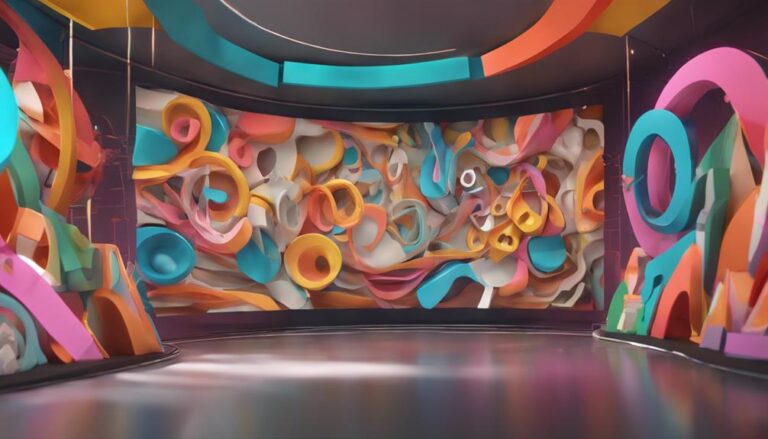5 Essential Rendering and Output Options for 2D Animations
When you're putting the finishing touches on your 2D animation, you're probably anxious to share it with the world. But before you do, take a step back and think about the rendering and output options that'll make or break your project's quality and compatibility. You've invested time and effort into creating something amazing, and now it's time to guarantee it looks just as great on every device and platform. From mastering resolution and aspect ratio to exporting in the right format, there are vital decisions to be made – and we're about to explore the top 5 essentials you can't afford to overlook.
Key Takeaways
- Mastering resolution and aspect ratio balance file size and processing power for compatibility with various devices and screens.
- Optimize frame rate and speed by adjusting frames per second to achieve a smooth animation without compromising file size and efficiency.
- Choose the right color mode, such as Rec. 709 or sRGB, to ensure color consistency and compliance with intended display devices and platforms.
- Export animations in formats optimized for web and mobile devices, such as WebM, MP4, or GIF, to reduce file size and ensure smooth playback.
- Adhere to broadcast standards, such as resolution, frame rate, and color space requirements, to ensure high-quality video and audio for TV broadcasting.
Mastering Resolution and Aspect Ratio
When finalizing your 2D animation, you'll need to determine the ideal mastering resolution and aspect ratio to guarantee your project meets the required specifications for its intended platform or medium.
The mastering resolution refers to the maximum resolution at which your animation will be displayed, which directly affects pixel density. A higher pixel density results in a sharper image, but increases file size and processing power required. You'll need to balance these factors to guarantee your animation looks great on various devices.
For screen calibration, consider the intended display device's resolution and aspect ratio. For example, a 16:9 aspect ratio is standard for HD TVs, while 4:3 is more suitable for older screens.
Guarantee that your animation's aspect ratio matches the target device to avoid distortion or cropping. Additionally, consider the screen's calibration settings, such as brightness and color gamut, to guarantee your animation is optimized for the intended viewing environment.
Optimizing Frame Rate and Speed
Your animation's frame rate and speed directly impact its overall fluidity and visual appeal, so it's crucial to optimize these elements to guarantee a seamless viewing experience across various platforms.
To achieve this, you'll want to focus on frame optimization. Start by adjusting your animation's frame rate, which typically ranges from 24 to 60 frames per second (fps). A higher frame rate generally results in a smoother animation, but it also increases file size and processing demands. You'll need to strike a balance between quality and efficiency.
Next, apply speed tweaks to fine-tune your animation's pacing. You can adjust the speed of individual elements or entire scenes to create a more engaging and dynamic experience. Be cautious not to overdo it, as excessive speed changes can be jarring or disorienting.
Choosing the Right Color Mode
As you've optimized your animation's frame rate and speed, you're now ready to select a color mode that accurately represents your artistic vision and guarantees consistency across various devices and platforms.
When choosing a color mode, you'll need to think about the intended use of your animation and the devices it will be displayed on. For example, if your animation will be broadcast on TV, you'll want to use a color mode that adheres to broadcast standards, such as Rec. 709. If it's destined for online platforms, you may opt for a color mode like sRGB, which is optimized for digital displays.
Color consistency is vital, as it guarantees that your animation looks as intended, regardless of the device or platform. Think about applying color grading techniques to enhance the mood and atmosphere of your animation.
Saving for Web and Mobile
Export your 2D animation in formats optimized for web and mobile devices, guaranteeing seamless playback and efficient file sizes.
When preparing your animation for online distribution, think about the importance of Web Compression. This process reduces the file size of your animation, allowing for faster loading times and smoother playback on websites and social media platforms.
You can opt for formats like WebM, MP4, or GIF, each with its own strengths and weaknesses. For instance, WebM provides excellent compression ratios, while MP4 is widely supported across most platforms.
When it comes to Mobile Compatibility, it's vital to guarantee that your animation looks and plays back correctly on a range of devices and screen sizes.
You'll want to think about the resolution, aspect ratio, and encoding settings to guarantee that your animation is optimized for mobile viewing. By exporting in formats like MP4 or HLS, you can guarantee that your animation will be compatible with most mobile devices and platforms.
Exporting for Broadcast and TV
When preparing your 2D animation for broadcast and TV, you'll need to guarantee it meets the stringent technical requirements of these platforms, which differ dramatically from those of web and mobile distribution.
Specifically, you'll need to adhere to broadcast standards, guaranteeing your animation meets the formatting and resolution requirements of TV networks.
| Parameter | TV Broadcast Standard |
|---|---|
| Resolution | 1920 x 1080 (HD) or 1280 x 720 (SD) |
| Frame Rate | 29.97 fps (NTSC) or 25 fps (PAL) |
| Aspect Ratio | 16:9 (widescreen) or 4:3 (fullscreen) |
| Color Space | Rec. 709 (HD) or Rec. 601 (SD) |
| Audio | Stereo or 5.1 surround sound |
These specifications are vital to guarantee your animation is compatible with TV broadcasting systems.
Failure to meet these standards can result in poor video quality, audio issues, or even rejection by TV networks.
Frequently Asked Questions
How Do I Ensure Consistent Animation Quality Across Different Devices?
To guarantee consistent animation quality across devices, you'll want to focus on device agnosticism and playback optimization. You can achieve this by using scalable vector graphics, optimizing animation frames, and testing on diverse devices to guarantee smooth playback and consistent quality.
Can I Use 2D Animation Software for 3D Animation Projects?
You shouldn't assume 2D software can handle 3D animation projects; understanding 2D software limitations is key. Dispelling 3D animation misconceptions, you'll realize that 2D tools lack the capacity to generate complex 3D models and animations.
What File Formats Are Compatible With Most Video Editing Software?
You'll find that most video editing software supports common file formats like MP4, MOV, and AVI, which allow for efficient video compression and support various color profiles, such as sRGB, Rec. 709, and DCI-P3.
How Do I Add Watermarks or Subtitles to My Animated Videos?
You'll increase brand visibility by adding watermarks to your animated videos, maximizing screen real estate without overwhelming viewers. Use video editing software to overlay text or logos, adjusting opacity, size, and position to achieve ideal visual balance.
Are There Any Free or Open-Source 2D Animation Software Options?
You'll find excellent open-source alternatives like OpenToonz, Pencil2D, and Blender, which offer robust features without the hefty price tag. However, be aware of free trial limitations, such as watermarked exports or restricted features, when exploring these options.
Conclusion
Mastering resolution and aspect ratio is vital for peak quality and compatibility.
Optimizing frame rate and speed ensures that your animation runs smoothly and efficiently.
Choosing the right color mode is crucial for maintaining the intended visual aesthetic.
Selecting the correct output format guarantees that your animation is compatible with various devices and platforms.
By making informed decisions on these essential rendering and output options, you'll guarantee your animation looks its best on any device, from mobile screens to TV broadcasts.





